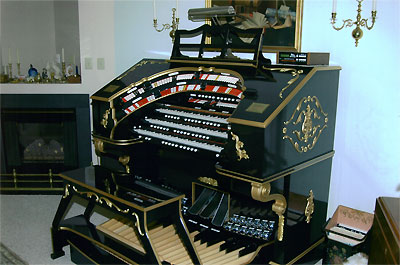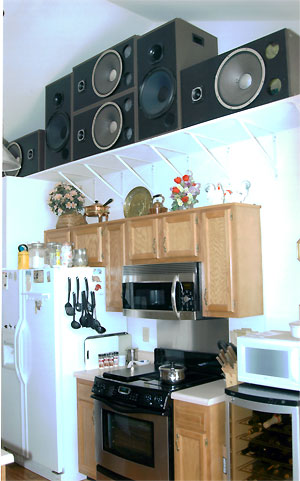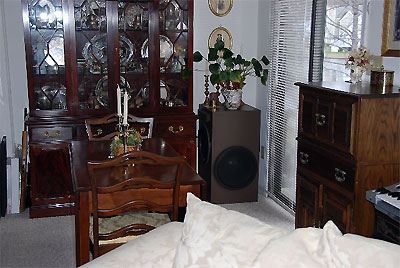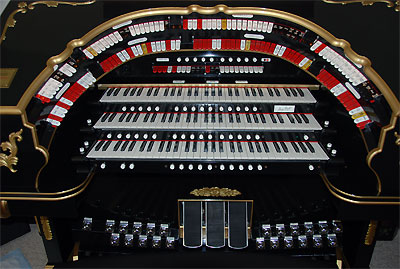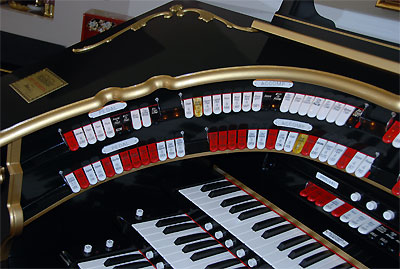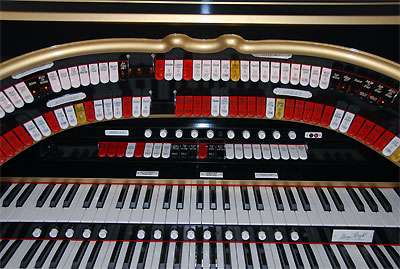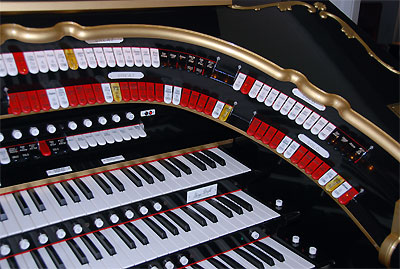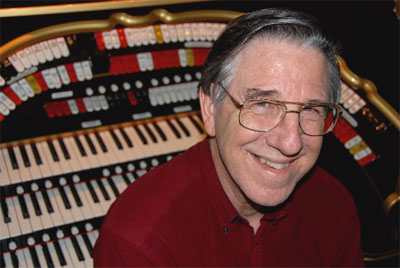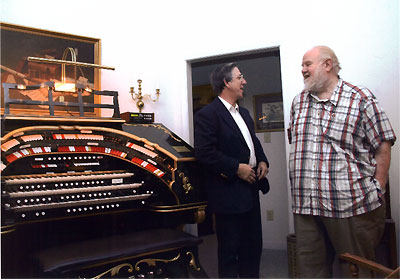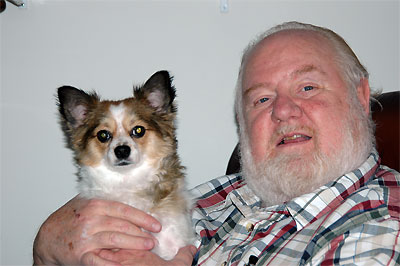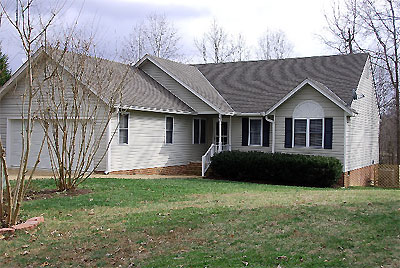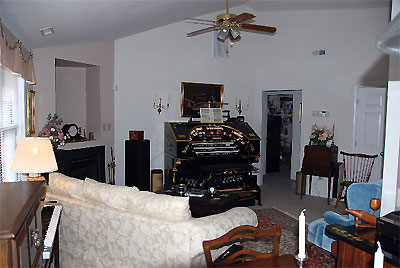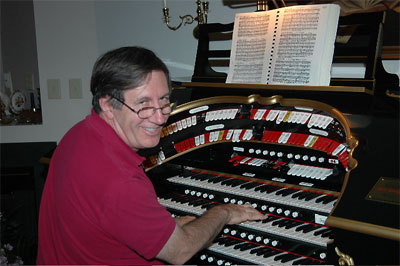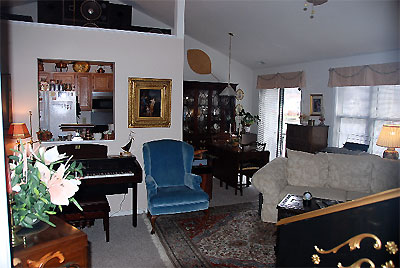
|
|
Mike Phillip's 3/19 Mighty Allen GW319EX Digital Theatre Organ
|
|
This month, we are featuring a Digital Theatre Organ installed in the residence of E. P. "Mike" Phillips of Chesterfield, Virginia. This lovely organ is the Allen GW319EX, an instrument of three manuals and nineteen ranks, having a custom gloss-black and gold leaf console hooked up to seven wide range loudspeakers and a subwoofer.
Mike's residence has an open floor plan wherein the living, dining, and kitchen areas are really one big room, having a nice acoustic due to the non-parallel walls and a high ceiling. The organ console domitates the living area, while the seven main wide range loudspeakers are installed on a self over the cooktop and cabinets in the kitchen.
|
A Closer Look at the Console |
|
Mike was generous enough to send us some high resolution up close and personal shots of the console. Click on each image to download the full-sized picture. These photographs are so clear that one can easily read the names on the many dozens of stop tongues!
In this view, we are looking down at the horseshoe, bristling with stops. This instrument, recently played in concert on November 2006 by world class organist Dick Smith, is simular to the organ which the illustrious and talented Tom Hoehn played at the Woodlands Retirement Community in Shell Point, Florida in the summer of 2006. But the Allen GW319EX, though much like its 317EX predicessor, is a much bigger and more refined organ, this particular example having a custom mirror-gloss jet-black finish complete with gold leaf trim and accents. The effect is eye-popping, to say the least. Although the model number hints at the fact that this organ has 19 ranks, in reality, there are 22. This is due to three double-rank Celestes. These Celestes give the Mighty Allen GW319EX a nice warm and lush sound when they are drawn, providing the instrument with a huge String ensemble that is available at 16', 8', and 4'. We are currently working on a stop list table that will depict the awesome resources available to the organist in this gorgeous world class console.
Here, we can see the stops for the Pedal and Accompaniment Organs. Note the 32' Contra Viol in the Pedal and that lovely 8' Quintadena as well. There is also a Pizzicatto Tibia for an authentic String Bass.
Moving around to the back rail, we see the stops for the Great Organ above the ones on the fall board. Check out those effect pistons, complete with A-B selection indicators. Also notice the vast Second Touch array for the Accompaniment and the nine Tremulants, one of which activiates the Vibraphone "Motor".
And finally, we see the stops of the Solo Organ to the right of center. The layout is standard WurliTzer fare, and sitting at the console and hearing the sound from the speakers would almost convince one that they were sitting at a genuine Theatre Pipe Organ. Allen really went all out on this organ, and it shows both in appearance and sound, complete with that difinative 1-3/5' Larigot in the Solo to add that unmistakable sheen to the full Tibia Chorus. |
Second Dick Smith Concert |
|
We were very fortunate to aquire a second recording from Mike featuring Dick Smith's artistry as he played 32 more songs on this magnificent instrument. To listen to this concert, click here. |
First Dick Smith Concert |
|
We were very fortunate to aquire a recording from Mike featuring the talent of Dick Smith, who played 31 songs on this magnificent instrument. To listen to this concert, click here.
|
About Mike Phillips |
|
We asked Mike to tell us a bit about himself and his instrument, and this was his reply. We quote him in blue text below: As a child, my mom would frequently take me with her to the Miller & Rhoads Tea Room for lunch. This was Richmond's finest department store and featured Eddie Weaver at the Hammond organ with a Steinway piano at a right angle so that he could play both of them at the same time. I really preferred his pop style over the classical stuff my two older sisters were learning how to play on the piano at home. I was probably around seven. My parents wanted me to take piano lessons as well, but I said, "No." I wanted to take organ lessons, but they said, "No." Eddie Weaver, in addition to his daily Tea Room duties, was also a well known theatre organist having played in Rochester, New York, for many years and then moving to Richmond where he was the featured organist at the Loews Theatre 3/13 WurliTzer, the Byrd Theatre's 4/17 Special WurliTzer, and the Mosque 3/17 WurliTzer. It was always a thrill to hear Eddie playing any one of our three Kings. Incidentally, all three organs are still here. The Byrd is played every Saturday at 7 and 9 PM. The Loews, now the Carpenter Center organ, is temporarily in storage while the theatre is being refurbished, and the Mosque, now the Landmark Theatre, is silent but still there. When I turned 18, and could get credit on my own, I bought my first Hammond L-100 and took the six free lessons that were included in the deal. I was hooked. I traded up to an M, then an E, and finally an H with twin Leslies. That was 1967, the year I got married. At about that time I met Bill and Marge Floyd, who had just moved to Richmond from the New York / New Jersey area where Bill played the Mighty WurliTzer at the Brookland Paramount Theatre, plus in the summers, he played another big Theatre Pipe Organ at Surf City, New Jersey. In 1971, I sold my Hammond H to a church and bought a Lowrey theatre model. Bill Floyd introduced me to Lee Stadele who was an Allen Organ dealer in New Jersey. In 1973, I sold my Lowrey and bought my first used organ, an Allen 4??, single MOS computer Digital Theatre Organ. It was white with a little gold, and was self contained except for a single external gyro speaker cabinet. In 1976, I built a new home that had a large great room with an open balcony, perfect for a larger Allen. Lee found a special 621 which was a two manual, multiple MOS computer Digital Theatre Organ. It had eight external cabinets and 7 rack-mounted amps. This was a magnificent Allen that I enjoyed for about 15 years. Then my wife and I became interested in boating. This distracted me from music for about ten years. Then I lost my wife to a stroke, sold the boat, and re-kindled my interest in theatre organs. We had planned to retire to our boat and spend our autumn years cruising the Chesapeake Bay. I had sold the Allen and my Steinway, and bought a Roland Atelier A70 which I installed on the boat. That little Roland was a joy to play. In the mean time, I bought my present little house (knowing it would probably be just me for the rest of my life.) I didn't require a lot of space as a single man. I then asked Lee to find another Allen and he came up with a cream puff MDS 312. It was self contained, but we added two Herald 200 cabinets which I placed directly on top of my kitchen cabinets as there was really no place else for them to fit. The MDS 312 never really satisfied my desire for "the big sound". So, having been spoiled by the big sound of the more powerful 621, I asked Lee to find a cream puff 317 for me. He said, "No" because he did not think that would satisfy my wants. We were at odds for a few months. And then, he presented me with the idea of the Allen GW319EX. It was way over my budget, but Lee said he could be creative in the deal structure. Then he dropped the bomb! It was gloss black! I had seen pictures of the flat black EX that Allen had been advertising and I did not care for it. He was relentless. He said, "Mike, this is the organ for you. It is a world class instrument that you will forever regret not buying!" So, I agreed to at least look at a picture of it. As soon as I saw the photo, that was it. So, Lee put the deal together to everyone's satisfaction. Of course, buyer's remorse set in immediately. How was I going to install this thing so that it would fit my space? But after a few days of evaluating the room and what would be arriving in a few weeks, I came up with a plan. The Allen GW319EX was installed in May of 2005, and now you folks at Walnut Hill are, I hope, enjoying the sounds of this fine instrument.
My neighbor, Les Hickory, also an accomplished theatre organist and musician, was most helpful by specifying and installing the shelves and running the wiring to accommodate "Black Beauty" ("BB" for short.) Les has also been indispensable with tweaking all those little things that tend to present themselves in a project of this magnitude. It was a Godsend to me when Les and his wife Mary relocated here from Saint Louis to be closer to their children. I had known Les back in 1970 when he performed a couple of concerts on my Hammond H, but I had not seen nor heard from him for 35 years. Now he lives in the same community as me and we are enjoying a great friendship once again. What a small and wonderful world! Les is a fine organist and he is the technician that keeps Black Beauty going to this day. Walt Strony voiced "BB" in Oct 2005. Les and I have tweaked it a little since then, but nothing serious. So, once again, Lee Stadele, thanks for pushing me. You were right! "BB" is exactly what I was looking for! I am turning 64 in March and have my share of health problems. But, with great friends, a loving daughter and son-in-law, a nice little house with all the conveniences I need, and Black Beauty, I can thankfully say that I am happy. And now, you know the rest of the story. Thanks muchly, Sir Mike! We are greatly indebted to you for sharing with us this magnificent machine and the music she makes, indeed. |
